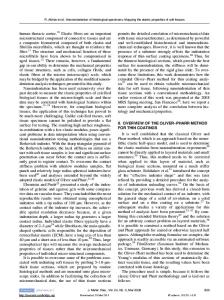Nanoindentation of Histological Specimens using an Extension of the Oliver and Pharr Method
- PDF / 1,254,336 Bytes
- 6 Pages / 612 x 792 pts (letter) Page_size
- 87 Downloads / 305 Views
1097-GG01-09
Nanoindentation of Histological Specimens using an Extension of the Oliver and Pharr Method Riaz Akhtar1, Michael J Sherratt2, Nick Bierwisch3, Brian Derby1, Paul M Mummery1, Rachel E.B Watson4, and Norbert Schwarzer3 1 Manchester Materials Science Centre, School of Materials, The University of Manchester, Grosvenor Street, Manchester, M1 7HS, United Kingdom 2 Tissue Injury and Repair Group, Faculty of Medical and Human Sciences, The University of Manchester, 1.581 Stopford Building, Oxford Road, Manchester, M13 9PT, United Kingdom 3 Saxonian Institute of Surface Mechanics (SIO), Tankow 1, Ummanz, 18569, Germany 4 Dermatological Sciences Research Group, Faculty of Medical and Human Sciences, The University of Manchester, 1.443 Stopford Building, Oxford Road, Manchester, M13 9PT, United Kingdom ABSTRACT The micro-mechanical properties of 5 μm thick histological sections of ferret aorta and vena cava were mapped as a function of distance from the outer adventitial layer using nanoindentation. In order to decouple the effect of the glass substrate on the elastic modulus of these thin sections, the nanoindentation data were analyzed using the extended Oliver and Pharr method which is readily accessible for coatings and layered materials with the software package, FilmDoctor®. In the aorta, the elastic modulus was found to decrease progressively from 35 MPa at the adventitia (outermost layer) to 8 MPa at the intima (innermost layer). This decrease in modulus was inversely correlated with elastic fibre density. In contrast, in the vena cava, the stiffest regions were found to be the adventitial (outer) and intimal (innermost) sections of the vessel crosssection. Both these regions were enriched in ECM components. The central region, thought to be largely cellular, had a relatively constant modulus of around 20 MPa. This study demonstrates that with this methodology it is possible to distinguish micro-mechanically between large arteries and veins, and therefore the same approach should allow age or disease related changes in the mechanical properties within a tissue to be quantified.
INTRODUCTION The composition of the extracellular matrix (ECM) determines the mechanical properties of dynamic connective tissues such as blood vessels, the lungs and skin [1]. Within the ECM long-range deformability and passive recoil is conferred primarily by elastic fibers, which are composite structures composed of an inner cross-linked elastin core and an outer mantle of fibrillin-rich microfibrils [2]. Large arteries, such as the aorta, buffer variations in blood pressure and may undergo more than 2 x 109 extension and relaxation cycles during a human lifetime. As a consequence of these physiological demands, large arteries are highly enriched in elastin which may comprise up to 22% of the dry weight of normotensive human thoracic aorta [3]. Reduced tissue elasticity is a major factor in age- and disease-related morbidity and mortality. In the ageing lung, loss of elastic recoil reduces forced vital capacities which has a
Data Loading...











